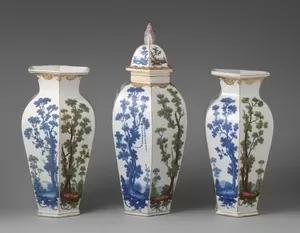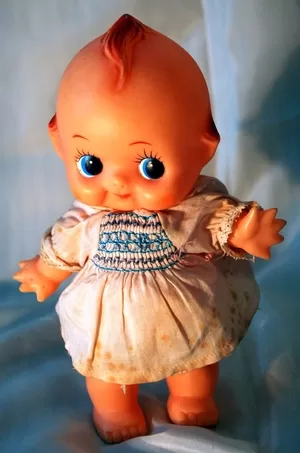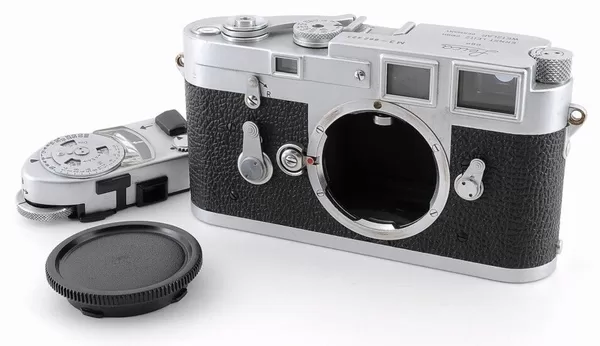The fashion for decorating the chimney piece with sets of ceramic ornaments began in the 17th century and continued for close to 300 years.
The French term, garniture de cheminée, means ‘chimney decorations’ and is used to describe sets of vases and similar ornaments that have been made to be placed on a mantelpiece.
In England, garnitures first became fashionable in the 17th century. At this time, sets of blue and white porcelain vases began to be imported from China, where they had long been used to decorate reception rooms and altars.
Japanese Imari garnitures were also imported, while the Dutch made earthenware blue and white sets in Delft.
Once European potters – beginning with the Meissen factory in the 1720s – had unlocked the secrets of its manufacture, they began to turn out porcelain versions, mimicking Chinese shapes and decorative styles.
Garnitures of three, five and seven pieces were made, though five was the most common.
The typical set had three lidded, baluster-shaped vases and two trumpet-shaped ‘beakers’. One of the vases was bigger than the others, and made to be placed centrally.


Garniture of three Bristol porcelain vases, c. 1773, painted by Michel Socquet.
From Amazon: GARNITURES Hardcover in English by Ferguson Patricia
Published by Victoria Albert
This exquisite gift book explores the phenomenon of ‘garnitures’, or matching sets of ceramic vases. From the 1650s such sets were used in elite European interiors as an integral part of the decorative scheme; displayed on chimney-pieces, cupboards, tables or over doors, they ‘garnished’ the interior and so enhanced the status of the owner
European Styles of Garnitures
As the 18th century wore on, the standard Chinese shapes were supplanted by European rococo and classical styles.


Château de Versailles, salon des nobles, garniture de cheminée
The meaning of the word garniture extended to include sets of figures and candleholders, while garnitures with a clock cased in porcelain, metal or stone as their centrepiece also made an appearance.
In the 1770s, Josiah Wedgwood broke into the market with garnitures of his ornamental stonewares, jasper ware and black basaltes.
Standard 19th-century garnitures had three pieces. They were made in great numbers through the Victorian period. The market increased along with the size of the middle class and the general standard of living.
Garnitures were increasingly made of materials other than porcelain. Bone china, decorative stonewares such as Mason’s Ironstone, parian ware and even earthenware were all used to make mantel ornaments, some of which were a long way from the narrow and very precise definition of mantelpiece garnitures that was used in the 18th century.
At the end of the 19th century, some garnitures were produced in art nouveau styles in materials such as pewter, while a few were made in the 1930s in art deco styles.
However, the great majority of garnitures continued to be made in traditional ceramic forms, with naturalistic decoration, until they finally drifted out of fashion before World War 2.
Whether placed on the mantelpiece, as intended, or on a piece of furniture, as here, even an incomplete garniture set will add a touch of elegant decoration to an interior.
Garnitures from the 17th and 18th centuries, including imported oriental ware, early pieces made by continental or British porcelain factories or products of the Wedgwood factory, are scarce and tend to be very expensive.
Mid- to late 19th-century garnitures are more plentiful, so more affordable, though by no means always cheap. You will find them at specialist dealers and in auctions.
They tend to turn up much more rarely in bargain outlets, such as flea markets and car boot sales, because their decorative nature makes people think they are worth something.
Always consider a piece carefully before making an offer or bid for it. Condition is important, as ever.
Slight damage, such as a small chip inside the rim, rubbed gilt or a small crack, is usually acceptable, though it should be reflected in a slightly lower price.
Check around the most vulnerable spots, such as the rim, the handles and the neck of the base. Use your hands as well as your eyes, feeling for cracks or the changes in texture that indicate a piece has been restored.
Look for signs of wear at the handle and rim. If they are absent, the piece has either been skilfully restored or is a reproduction.
Garnitures – Makers’ Marks
The best guides to the date are the piece’s style and any makers’ marks on the base. Take a handbook of marks with you when you shop.
If the base has a diamond-shaped mark which contains the letters Rd, the design was registered between 1842 and 1883.
Look inside lidless vases. If there is a flange inside the neck, it had a lid once, but this has since been lost. Remember that a garniture set always had an odd number of pieces. An even numbered group is either incomplete or was not made as a garniture set in the first place.
Further Reading and References on Garnitures:
From Amazon: GARNITURES Hardcover in English by Ferguson Patricia
Published by Victoria Albert
This exquisite gift book explores the phenomenon of ‘garnitures’, or matching sets of ceramic vases. From the 1650s such sets were used in elite European interiors as an integral part of the decorative scheme; displayed on chimney-pieces, cupboards, tables or over doors, they ‘garnished’ the interior and so enhanced the status of the owner
Good standards are Warman’s English & Continental Pottery & Porcelain (Susan and Al Bagdade), and Marks & Monograms on European and Oriental Pottery and Porcelain (William Chaffers).
Our other features stories on Ceramics:
FEATURE: All About Pottery & Ceramics
V&A acquires rare Wedgwood tea & coffee set from Karl Lagerfeld estate
Value of Collecting Chinese Porcelain Chinese Dynasties
Ceramics & Pottery from around the World
Collecting Old European & Chinese Snuff Bottles






